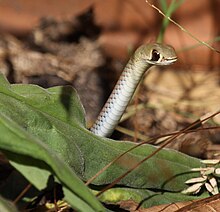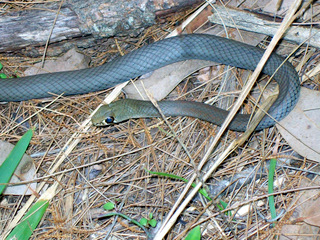Yellow-faced whipsnake
This article needs additional citations for verification. (December 2016) |
| Demansia psammophis | |
|---|---|

| |
| Scientific classification | |
| Domain: | Eukaryota |
| Kingdom: | Animalia |
| Phylum: | Chordata |
| Class: | Reptilia |
| Order: | Squamata |
| Suborder: | Serpentes |
| Family: | Elapidae |
| Genus: | Demansia |
| Species: | D. psammophis
|
| Binomial name | |
| Demansia psammophis (Schlegel, 1837)
| |
| Synonyms[1] | |
| |
The yellow-faced whip snake (Demansia psammophis) is a species of venomous snake in the family Elapidae, a family containing many dangerous snakes.
Description
D. psammophis is a long thin snake with a narrow head. Dorsally, it is greyish green to grayish blue in colour. Below the eye is a black "comma"-like marking which extends to the edge of the lip; this black marking is edged with yellow in front and behind. A white-edged dark line is seen across the snout, especially in juveniles.
Average total length (including tail) is 80 cm (31 in), maximum 1.2 m (47 in). Hatchlings are 20 cm (7.9 in) long.
Distribution and habitat
D. psammophis is endemic to Australia.
Behaviour
Although not an aggressive species, the bite of D. psammophis is to be avoided, as extreme pain will affect the bitten limb.
Diet
D. psammophis is a lizard eating specialist, and it is common throughout its range.

References
- ^ "Demansia psammophis ". The Reptile Database. www.reptile-database.org.
Sources
- Weigel, John (2002). Australian Reptile Park's Guide to Snakes of South-east Australia. ISBN 0-646-00006-3. (Demansia psammophis, p. 50).
- "Demansia psammophis ". Integrated Taxonomic Information System. www.itis.gov.
Further reading
- Boulenger GA (1896). Catalogue of the Snakes in the British Museum (Natural History). Volume III., Containing the Colubridæ (Opisthoglyphæ and Proteroglyphæ) ... London: Trustees of the British Museum (Natural History). (Taylor and Francis, printers). xiv + 727 pp. + Plates I-XXV. (Diemenia psammophis, pp. 322–323).
- Schlegel H (1837). Essai sur la physionomie des serpens. Amsterdam: M.H. Schonekat. Partie générale, xxviii + 251 pp.; Partie descriptive, 606 + xvi pp. (Elaps psammophis, new species, p. 455). (in French).
